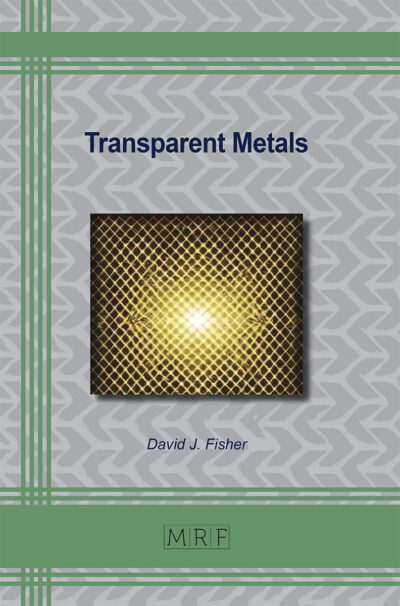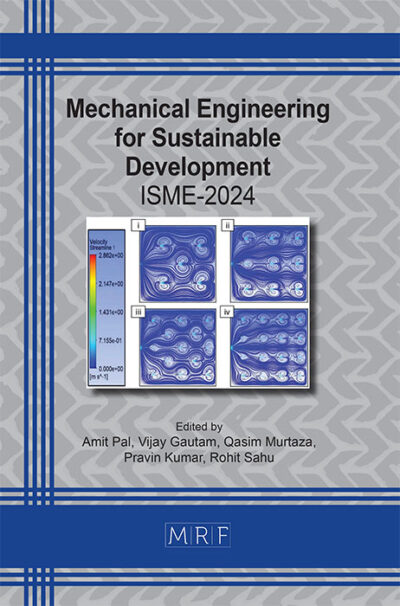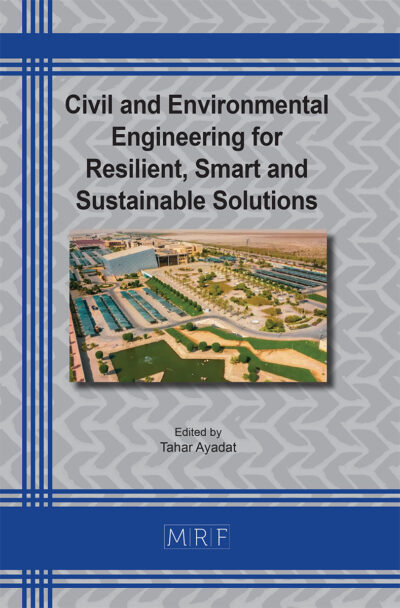Development model of small orifice flow using simple linear and multilinear regression
Dina P.A HIDAYAT, Sih ANDAJANI, Muhammad A.G IMANULLAH
Abstract. The concept of “small orifice flow” describes the movement of a fluid through a tiny hole or orifice. This is a typical occurrence in engineering and fluid mechanics. In machine learning, linear regression is a fundamental and extensively used technique for modelling the connection. In this research, an analysis of the influence of the variables H1, H2 and Q was carried out on the output value of the discharge coefficient (Cd). Model evaluation is done by calculating calibration parameters like the coefficient of determination. R square (R2), also known as the coefficient of determination, describes the extent to which dependent data can be described by independent data. There are a total of 47 datasets that will be included in the development of linear and multilinear models. In this study, 90% (42) of the training data and 10% (5) of the total test data were used. Based on simple linear model, Q parameter having a stronger linear relationship with the Cd parameter compared to the H1 and H2 parameters with a strong multiple R value of 0,754 and moderate R2 correlation value of 0.569. There is a significant influence between the variables Q and Cd based on significant F value. The multilinear regression method was chosen because of its statistical data handling capabilities and ease of creation, implementation, and operation. the multilinear regression model with H1, H2 and Q values as independent variables can explain the Cd value as the dependent variable very well with the higher value of multiple R and R2, and small error value.
Keywords
Laboratory, Linear Regression, Machine Learning, Model, Orifice Flow
Published online 2/25/2025, 9 pages
Copyright © 2025 by the author(s)
Published under license by Materials Research Forum LLC., Millersville PA, USA
Citation: Dina P.A HIDAYAT, Sih ANDAJANI, Muhammad A.G IMANULLAH, Development model of small orifice flow using simple linear and multilinear regression, Materials Research Proceedings, Vol. 48, pp 746-754, 2025
DOI: https://doi.org/10.21741/9781644903414-81
The article was published as article 81 of the book Civil and Environmental Engineering for Resilient, Smart and Sustainable Solutions
![]() Content from this work may be used under the terms of the Creative Commons Attribution 3.0 license. Any further distribution of this work must maintain attribution to the author(s) and the title of the work, journal citation and DOI.
Content from this work may be used under the terms of the Creative Commons Attribution 3.0 license. Any further distribution of this work must maintain attribution to the author(s) and the title of the work, journal citation and DOI.
References
[1] B. Fu et al., “Spatio-temporal coupling coordination analysis between marsh vegetation and hydrology change from 1985 to 2019 using LandTrendr algorithm and Google Earth Engine,” Ecol. Indic., vol. 137, no. February, p. 108763, 2022. https://doi.org/10.1016/j.ecolind.2022.108763.
[2] A. C. P Fernandes, A. R Fonseca, F. A. L. Pacheco, and L. F. Sanches Fernandes, “Water quality predictions through linear regression – A brute force algorithm approach,” MethodsX, vol. 10, no. January, p. 102153, 2023. https://doi.org/10.1016/j.mex.2023.102153.
[3] M. A. Rehman, N. Abd Rahman, A. N. H. Ibrahim, N. A. Kamal, and A. Ahmad, “Estimation of soil erodibility in Peninsular Malaysia: A case study using multiple linear regression and artificial neural networks,” Heliyon, vol. 10, no. 7, p. e28854, 2024. https://doi.org/10.1016/j.heliyon.2024.e28854.
[4] M. R. Elkharbotly, M. Seddik, and A. Khalifa, “Toward Sustainable Water: Prediction of non-revenue water via Artificial Neural Network and Multiple Linear Regression modelling approach in Egypt,” Ain Shams Eng. J., vol. 13, no. 5, p. 101673, 2022. https://doi.org/10.1016/j.asej.2021.101673.
[5] N. HASYDNA and R. K. DINATA, “Machine Learning.” Unimal Press, 2020, [Online].
Available: http://repository.unimal.ac.id/id/eprint/6707.
[6] A. Roihan, P. A. Sunarya, and A. S. Rafika, “Pemanfaatan Machine Learning dalam Berbagai Bidang : Review paper,” vol. 5, no. April, pp. 75–82, 2020.
[7] R. G. Wardhana, G. Wang, and F. Sibuea, “Penerapan Machine Learning Dalam Prediksi Tingkat Kasus Penyakit Di Indonesia,” J. Inf. Syst. Manag., vol. 5, no. 1, pp. 40–45, 2023. https://doi.org/10.24076/joism.2023v5i1.1136.
[8] H. C. Kraemer and C. Blasey, “Linear Regression Analysis,” How Many Subj. Stat. Power Anal. Res., pp. 73–85, 2017. https://doi.org/10.4135/9781483398761.n6.
[9] G. K. Adari, M. Raja, and P. Vijaya, “Chapter 3 – Machine learning in genomics: identification and modeling of anticancer peptides,” A. K. Tyagi and A. B. T.-D. S. for G. Abraham, Eds. Academic Press, 2023, pp. 25–68.
[10] C. L. Cheng, Shalabh, and G. Garg, “Coefficient of determination for multiple measurement error models,” J. Multivar. Anal., vol. 126, pp. 137–152, 2014. https://doi.org/10.1016/j.jmva.2014.01.006.
[11] R. Bomvet, D. Saura, R. Jr, and M. Andante, “Detection of cyanide in freshwater fishes
relative to sex dimorphism using landmark-based geometric morphometrics in Agusan del Sur, Philippines,” Int. J. Biosci., vol. 12, no. 2, pp. 177–193, 2018. https://doi.org/10.12692/ijb/12.2.177-193.
[12] G. A. Nurunnisha, A. Rohmattulah, M. R. Maulansyah, and O. Sinaga, “Analysis of Consumer Acceptance Factors Against Fintech At Bandung SMEs,” Palarch’s J. Archeol. Egypt / Egyptol., vol. 17, no. 5, pp. 841–856, 2020.
[13] A. Assidiq, P. Hendikawati, and N. Dwidayati, “Perbandingan Metode Weighted Fuzzy Time Series, Seasonal Arima, dan Holt-Winter’s Exponential Smoothng untuk Meramalkan Data Musiman,” Indones. Gedung D7 Lt.1, Kampus Sekaran Gunungpati, vol. 6, no. 2, pp. 129–142, 2017, [Online]. Available: http://journal.unnes.ac.id/sju/index.php/ujm.
[14] Y. Astuti, I. R. Wulandari, A. R. Putra, and N. Kharomadhona, “Naïve Bayes untuk Prediksi Tingkat Pemahaman Kuliah Online Terhadap Mata Kuliah Algoritma Struktur Data,” J. Edukasi dan Penelit. Inform., vol. 8, no. 1, p. 28, 2022. https://doi.org/10.26418/jp.v8i1.48848.
[15] E. Karyadiputra and N. Hijriana, “Analisis Penerapan Algoritma Naive Bayes Untuk Klasifikasi Prioritas Pengembangan Jalan Di Provinsi Kalimantan Selatan,” Technol. J. Ilm., vol. 9, no. 2, p. 105, 2018. https://doi.org/10.31602/tji.v9i2.1374.
[16] H. Roopa and T. Asha, “A Linear Model Based on Principal Component Analysis for Disease Prediction,” IEEE Access, vol. 7, pp. 105314–105318, 2019. https://doi.org/10.1109/ACCESS.2019.2931956.
[17] D. Maulud and A. M. Abdulazeez, “A Review on Linear Regression Comprehensive in Machine Learning,” J. Appl. Sci. Technol. Trends, vol. 1, no. 2, pp. 140–147, 2020. https://doi.org/10.38094/jastt1457.
[18] A. Kayode Coker, “CHAPTER 1 – Numerical Computation,” in Fortran Programs for Chemical Process Design, Analysis, and Simulation, vol. 1, 1995, pp. 1–102.
[19] G. K. Uyanık and N. Güler, “A Study on Multiple Linear Regression Analysis,” Procedia
– Soc. Behav. Sci., vol. 106, pp. 234–240, 2013. https://doi.org/10.1016/j.sbspro.2013.12.027.
[20] O. Ø. Smedegård, T. Jonsson, B. Aas, J. Stene, L. Georges, and S. Carlucci, “The implementation of multiple linear regression for swimming pool facilities: Case study at Jøa, Norway,” Energies, vol. 14, no. 16, pp. 1–23, 2021. https://doi.org/10.3390/en14164825.












